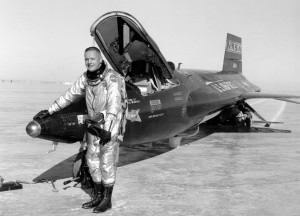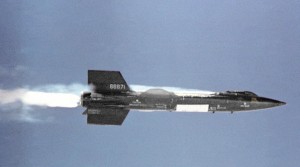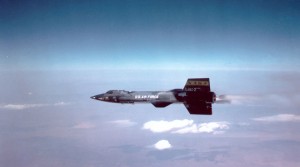Published July 16, 2012
News Flash: The USAF and NASA have announced an air-launched, hypersonic research aircraft capable of flying from the lower atmosphere into space (achieving altitudes above 100 kilometers) and returning for a landing on a normal runway. The aircraft is air-launched and utilizes rockets to accelerate to atmospheric speeds of over 3,500 mph (and as high as Mach 6.7).
Such an announcement would be exciting today — yet what it is even more startling is that this news dates from a nine year long test program that ended 44 years ago with its last flight on October 24, 1968. The aircraft was the X-15A, an all black, rocket-powered X-plane that was the descendent of Chuck Yeager’s venerable X-1 “Glamorous Glennis.” On this date in aviation history, in 1962, test pilot Joseph A Walker took the X-15 to what was then a new record altitude of 32,600 meters — while impressive, that record would soon be broken on subsequent flights.
In fact, the plane would fly so high that it would literally enter space. Had the budget been made available, follow on X-planes could well have become orbital spacecraft and history would have been dramatically different. Perhaps because of the military implications of missiles (i.e., nuclear weapons mounted atop ICBMs), the missileers won the budgetary fight and NASA would pursue the Mercury program. The earlier idea of flight into space was summarily cancelled.
Record-Breaking Flights
Nonetheless, the X-15 program would set some amazing records and gather an extraordinary amount of flight data. The three X-15As built would rack up 199 powered flights between them during the program at the hands of twelve pilots — X-15A-1 flew 82 powered flights, X-15A-2 flew 53 powered flights, and X-15A-3 flew 64 powered flights. The aircraft would be dropped from underneath a B-52 Stratofortress (actually, an NB-52A and NB-52B) that was specially modified for the project. Once air dropped, the X-15A would ignite its rockets while in a level glide and, with a high-g kick, would soar upward to the outer limits of the atmosphere at hypersonic speeds.

The Right Stuff
The X-15 program would be one of the last of the great programs flown in the X-plane series. Like all such programs, it would involve serious risk in the quest to “go higher and faster than ever before.” One pilot would be injured in a landing accident and then later, tragically, test pilot Michael J. Adams would die after his X-15 flight (#191 in the series) reached 3,569 mph (5,744 km/h) and an altitude of 50.3 miles (81.0 km) on November 15, 1967. While descending, the plane would depart controlled flight and break up at high altitude. Pieces were spread over 50 square miles.
To Space and Back
On thirteen flights, the test pilots would go beyond the edge of what the USAF defined as space — 50 miles of altitude (80.5 km). Twice, both in the hands of test pilot Joseph A. Walker, the X-15 would fly higher than 100 kilometers of altitude, thus achieving the altitude that is internationally accepted as the definition of space. The plane would also explore hypersonic aerodynamics and engineering challenges with trans-atmospheric flight. It would routinely fly faster than 3,500 mph. At the end of each flight, the aircraft would descend and land on retractable landing skids.
By the late 1950s, the USAF was already well along in planning its own orbital X-15 space plane program. Given the budget, there is no doubt that the USAF would have beaten NASA into orbit. The USAF program involved mounting an X-15B atop a North American SM-64 Navajo missile, resulting in high flight tempo (faster times between flights) on a smaller platform and at a comparatively much lower cost than rocket-powered missiles to put satellites into orbit. However, this and the later Boeing X-20 Dyna-Soar project were both cancelled once NASA elected to pursue Project Mercury. If the decision had gone the other way, the history of manned space flight would have been very different indeed.
One More Bit of Aviation Trivia
Eight of the twelve pilots who flew in the X-15 program received astronaut wings for flying higher than 50 miles of altitude. Two of the pilots would continue into space as part of NASA’s manned rocket programs. Joe H. Engle would become a NASA astronaut and would later command the space shuttle. His other colleague, however, would become a household name for a more famous flight when former X-15 test pilot Neil Armstrong would be the first man to step onto the surface of the Moon, taking “one small step for man….”




Re: Cancellation of hypersonic flights in favor of rockets.
This is a classic example of political short sightedness. Afraid of being outdistanced by the Soviets, the US politicians poured money into the Mercury and Gemini programs in order to ‘catch up’. Anybody telling them the X-15 program did nearly the same as Mercury (look at Joe Engle’s flights) was shouted down. Billions of dollars have been squandered following this false trail – that abruptly ended in the early 1970’s. The Shuttle was a halfway house between true flight and sitting on top of a rocket.
Maybe they will come to their collective senses now though I doubt it.
About 6-8 years ago, I met Scott Crossfield, one of the X-15A pilots, and asked about this very topic. His response was that “we were flying our way to space just fine until the rocket guys came along. Left to ourselves with a budget, we would have flown into orbit for a fraction of the cost.”
It is worth noting that the rocket guys definitely flew higher than the X-15A ever did and faster and farther. Then again, who knows what the X-15B would have achieved, and what of the next generation of space plane beyond that? The military implications of rocketry for ICBMs is compelling, without a doubt. And since much of the space program was motivated by military goals, then we have to recognize that not as “political short-sightedness”, but rather political imperative to respond to security threats.
Today, those security threats are a thing of the past. Orbital adopted the X-15A approach in their commercial launch vehicle, which was dropped from under the wing of a B-52 — it proved a perfectly good path to space. Today, Richard Branson’s venture similarly uses a space plane that is launched from another aircraft that carries it to altitude. The pathway of flying into space is far from dead — we just got back to restarting that because, all along, it was cheaper.